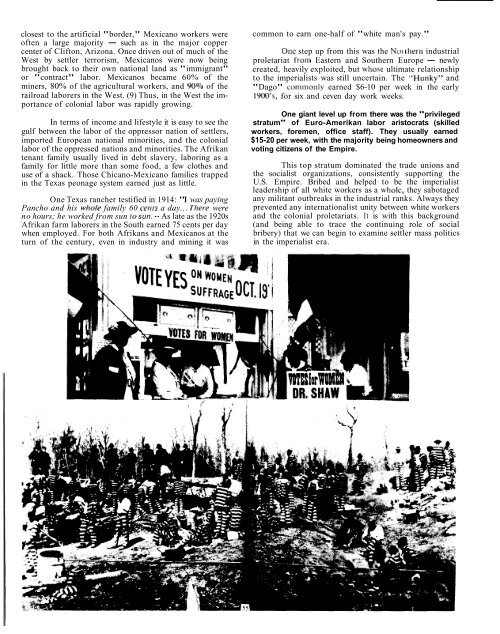Settlers - San Francisco Bay Area Independent Media Center
Settlers - San Francisco Bay Area Independent Media Center
Settlers - San Francisco Bay Area Independent Media Center
You also want an ePaper? Increase the reach of your titles
YUMPU automatically turns print PDFs into web optimized ePapers that Google loves.
closest to the artificial "border," Mexicano workers were<br />
often a large majority - such as in the major copper<br />
center of Clifton, Arizona. Once driven out of much of the<br />
West by settler terrorism, Mexicanos were now being<br />
brought back to their own national land as "immigrant"<br />
or "contract" labor. Mexicanos became 60% of the<br />
miners, 80% of the agricultural workers, and 90010 of the<br />
railroad laborers in the West. (9) Thus, in the West the importance<br />
of colonial labor was rapidly growing.<br />
In terms of income and lifestyle it is easy to see the<br />
gulf between the labor of the oppressor nation of settlers,<br />
imported European national minorities, and the colonial<br />
labor of the oppressed nations and minorities. The Afrikan<br />
tenant family usually lived in debt slavery, laboring as a<br />
family for little more than some food, a few clothes and<br />
use of a shack. Those Chicano-Mexicano families trapped<br />
in the Texas peonage system earned just as little.<br />
One Texas rancher testified in 1914: "I was paying<br />
Pancho and his wl?ole family 60 cents a day.. . Tliere were<br />
no hours; he worked from sun to sun. " As late as the 1920s<br />
Afrikan farm laborers in the South earned 75 cents per day<br />
when employed. For both Afrikans and Mexicanos at the<br />
turn of the century, even in industry and mining it was<br />
common to earn one-half of "white man's pay."<br />
Onc step up from this was the Nut lhern industrial<br />
proletariat from Eastern and Southern Europe - newly<br />
created, heavily exploited, but whoce ultimate relationship<br />
to the imperialists was still uncertain. The "Hunky" and<br />
"Dago" con~~nonly earned $6-10 per week in the early<br />
19001s, for six and ceven day work weeks.<br />
One giant level up from there was the "privileged<br />
stratum" of Euro-Amerikan labor aristocrats (skilled<br />
workers, foremen, office staff). They usually earned<br />
$15-20 per week, with the majority being homeowners and<br />
voting citizens of the Empire.<br />
This top stratum dominated the trade unions and<br />
the socialist organizations, consistently supporting the<br />
U.S. Empire. Bribed and helped to be the imperialist<br />
leadership of all white workers as a whole, they sabotaged<br />
any militant outbreaks in the industrial ranks. Always they<br />
prevented any internationalist unity between white workers<br />
and the colonial proletariats. It is with this background<br />
(and being able to trace the continuing role of social<br />
bribery) that we can begin to examine settler mass politics<br />
in the imperialist era.

















